The global DL-3-Hydroxybutyrate Calcium market is projected to grow from USD 32.7 million in 2025 to approximately USD 55.3 million by 2035, recording an absolute increase of USD 22.6 million over the forecast period. This translates into a total growth of 69.1%, with the market forecast to expand at a compound annual growth rate (CAGR) of 5.4% between 2025 and 2035. The overall market size is expected to grow by nearly 1.69X during the same period, supported by rising demand for ketogenic dietary supplements and increasing applications in functional food formulations.
The first half of the decade will witness steady expansion from USD 32.7 million to USD 42.5 million by 2030, adding USD 9.8 million in market value. This phase represents 43.4% of the total forecast growth, driven by growing consumer awareness of ketogenic benefits and expanding health product applications. Manufacturing capacity additions and quality standardization initiatives across key production regions will support this initial growth phase.
The latter half will experience accelerated momentum from 2030 to 2035, with the market reaching USD 55.3 million by adding another USD 12.8 million. This period constitutes 56.6% of the overall ten-year expansion, characterized by broader adoption across food additive applications and enhanced production technologies enabling higher purity grades. Market participants can expect intensified competition and consolidation activities as the industry matures toward the decade's end.
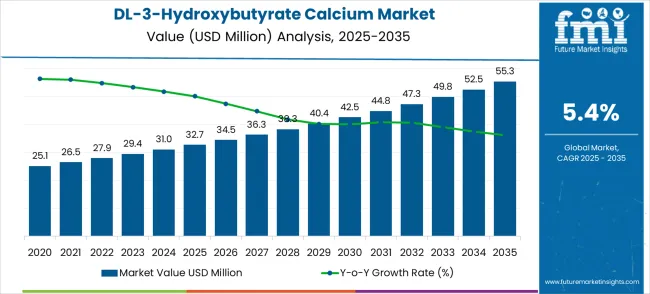
Between 2025 and 2030, the DL-3-Hydroxybutyrate Calcium market is projected to expand from USD 32.7 million to USD 42.5 million, resulting in a value increase of USD 9.8 million, which represents 43.4% of the total forecast growth for the decade. This phase of growth will be shaped by rising penetration of ketogenic dietary supplements in consumer markets, increasing adoption of functional ingredients in health product formulations, and growing awareness among manufacturers about calcium salt advantages over sodium variants. Production facilities are expanding their synthesis capabilities to address the growing demand for pharmaceutical-grade compounds.
From 2030 to 2035, the market is forecast to grow from USD 42.5 million to USD 55.3 million, adding another USD 12.8 million, which constitutes 56.6% of the overall ten-year expansion. This period is expected to be characterized by the expansion of food additive applications, the integration of advanced purification technologies, and the development of standardized quality protocols across different end-use industries. The growing adoption of clean-label products and increasing regulatory approvals for food applications will drive demand for higher purity grades and specialized technical expertise.
| Metric | Value |
|---|---|
| Market Value (2025) → | USD 32.7 Million |
| Market Forecast (2035) ↑ | USD 55.3 Million |
| Growth Rate ★ | 5.4% CAGR |
| Purity Standards → | High-grade products (≥98%) |
| Application Diversity ★ | Health products |
The market demonstrates consistent expansion patterns across all major regions, with Asia Pacific manufacturing hubs maintaining cost advantages while North American and European markets focus on premium applications. Quality differentiation through purity grades creates distinct market tiers, enabling specialized positioning strategies for different customer segments and regulatory requirements.
Market expansion rests on three fundamental shifts:
The growth faces headwinds from raw material cost volatility, complex manufacturing requirements for achieving pharmaceutical-grade purity standards, and competition from alternative ketone delivery systems including medium-chain triglycerides and other beta-hydroxybutyrate salt forms that may offer specific advantages for certain applications.
The market is segmented by purity grade, application, and region. Primary Classification encompasses purity grades divided into Purity≥98%, Purity<98%, and Others based on analytical specifications. Secondary Breakdown includes applications categorized into health products, food additives, and pharmaceutical intermediates. Regional Structure spans North America, Europe, Asia Pacific, Latin America, and Middle East & Africa with distinct regulatory frameworks and market dynamics.
Purity grade segmentation reflects manufacturing capability differences and end-use quality requirements, with pharmaceutical and premium supplement applications demanding higher specifications. Application segments demonstrate varying growth trajectories based on regulatory approval status and consumer acceptance patterns across different product categories.
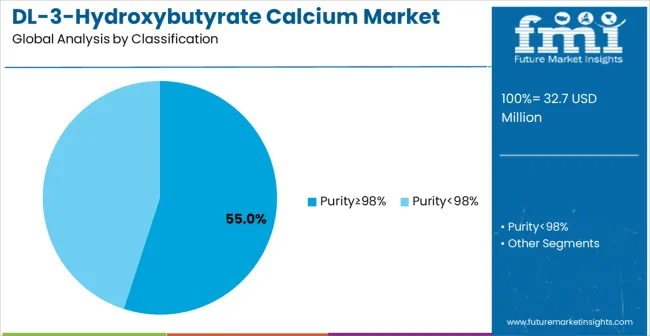
Purity≥98% grade is projected to account for 55% of the DL-3-Hydroxybutyrate Calcium market in 2025. This leading share is supported by the stringent quality requirements of dietary supplement manufacturers and pharmaceutical applications where product consistency and minimal impurities are essential for consumer safety and regulatory compliance. High-purity grades enable premium positioning and command higher margins while meeting international quality standards for export markets.
Market Position: The segment benefits from established purification technologies and comprehensive quality control systems that ensure batch-to-batch consistency required for commercial applications.
Value Drivers: Premium pricing for high-purity grades creates attractive revenue opportunities for manufacturers with advanced processing capabilities and quality certifications.
Competitive Advantages: Technical barriers to achieving consistent high-purity production create competitive moats for established manufacturers with specialized expertise and equipment investments.
The segment faces challenges from increased production costs associated with advanced purification processes and potential supply chain constraints during periods of high demand growth.
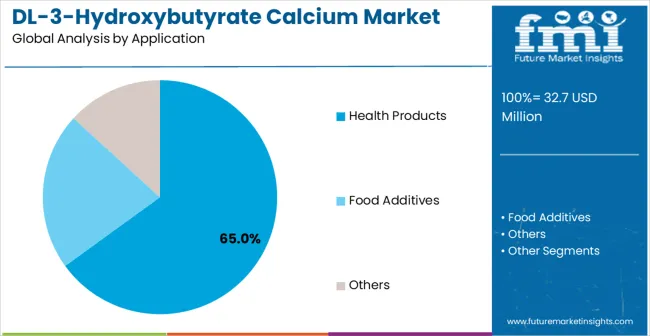
Health products are estimated to hold 65% of the market share in 2025, representing the largest application category for DL-3-Hydroxybutyrate Calcium consumption. This dominance reflects the ingredient's primary use in ketogenic supplements, sports nutrition products, and functional health formulations where metabolic benefits drive consumer demand.
Why dominant? The segment leverages growing consumer interest in metabolic health, weight management, and cognitive performance enhancement through ketogenic approaches.
What drives adoption? Increasing clinical research supporting beta-hydroxybutyrate benefits, expanding distribution through health food retailers, and growing acceptance among healthcare practitioners recommending ketogenic interventions.
Where is growth? Premium supplement brands, personalized nutrition products, and clinical nutrition applications represent the fastest-expanding subsegments within health products.
Forward-looking implications include potential market share expansion as regulatory approvals enable broader health claims and as consumer education increases understanding of exogenous ketone benefits beyond traditional ketogenic diet applications.
Growth Accelerators Rising consumer adoption of ketogenic dietary approaches drives demand for exogenous ketone supplements containing DL-3-Hydroxybutyrate Calcium. Expanding clinical research demonstrating metabolic and cognitive benefits validates commercial applications and supports premium pricing strategies. Regulatory approval processes advancing in major markets enable broader food and supplement applications while reducing commercialization barriers.
Growth Inhibitors Manufacturing complexity and high capital requirements for achieving pharmaceutical-grade purity limit supply chain expansion and create cost pressures. Raw material availability constraints and price volatility impact profit margins and long-term supply security. Regulatory uncertainty in emerging markets and varying international standards complicate global market development and product standardization efforts.
Market Evolution Patterns Quality differentiation through purity grade specifications creates distinct market segments with different price points and applications. Vertical integration trends among major manufacturers secure supply chains while improving quality control and cost management. Strategic partnerships between ingredient suppliers and finished product manufacturers drive innovation and market expansion across diverse application categories.
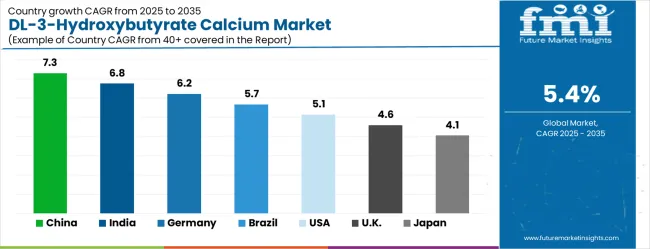
The DL-3-Hydroxybutyrate Calcium market demonstrates varied growth patterns across global markets, with Asia Pacific manufacturing centers leading production capacity while North American and European markets drive premium applications. Growth leaders include China at 7.3% CAGR and India at 6.8% CAGR, benefiting from manufacturing scale advantages and expanding domestic consumption. Steady performers encompass Germany at 6.2% CAGR and Brazil at 5.7% CAGR, representing mature markets with established supply chains and consistent demand growth. Emerging markets including the United States at 5.1% CAGR, United Kingdom at 4.6% CAGR, and Japan at 4.1% CAGR focus on high-value applications and premium product positioning.
Regional synthesis reveals manufacturing concentration in Asia Pacific countries driving cost competitiveness while developed markets emphasize quality differentiation and regulatory compliance. Market maturation levels vary significantly, with Asian markets expanding production capacity and Western markets developing advanced applications and premium product segments.
| Country | CAGR (2025-2035) |
|---|---|
| China | 7.3% |
| India | 6.8% |
| Germany | 6.2% |
| Brazil | 5.7% |
| United States | 5.1% |
| United Kingdom | 4.6% |
| Japan | 4.1% |
Revenue from DL-3-Hydroxybutyrate Calcium in China is projected to exhibit the highest growth rate with a CAGR of 7.3% through 2035, driven by manufacturing scale advantages, cost-effective production capabilities, and expanding domestic market demand. The country's chemical synthesis expertise and established pharmaceutical intermediate production infrastructure provide competitive advantages in producing high-quality DL-3-Hydroxybutyrate Calcium at commercially viable costs. Major chemical manufacturers are investing in specialized production lines and quality certification programs to serve both domestic and international markets with consistent product quality.
China's position as a global manufacturing hub enables efficient supply chain integration and cost optimization across raw material sourcing, production processes, and distribution networks. The domestic market expansion reflects growing consumer awareness of ketogenic dietary approaches and increasing disposable income supporting premium health product purchases. Export opportunities to developed markets drive quality improvements and international certification achievements among Chinese manufacturers.
Revenue from DL-3-Hydroxybutyrate Calcium in India is expanding at a CAGR of 6.8%, supported by increasing health consciousness among urban consumers, growing dietary supplement market penetration, and expanding pharmaceutical manufacturing capabilities. The country's established pharmaceutical industry provides technical expertise and production infrastructure suitable for specialty chemical synthesis including ketone body compounds. Domestic demand growth reflects rising disposable incomes, increasing awareness of metabolic health benefits, and expanding retail distribution of health and wellness products.
India's pharmaceutical manufacturing sector offers cost advantages while maintaining quality standards required for domestic and export markets. The regulatory environment continues evolving to support functional ingredient applications and dietary supplement formulations containing bioactive compounds. Growing consumer acceptance of preventive healthcare approaches creates expanding market opportunities for ketogenic and metabolic health products across urban and semi-urban populations.
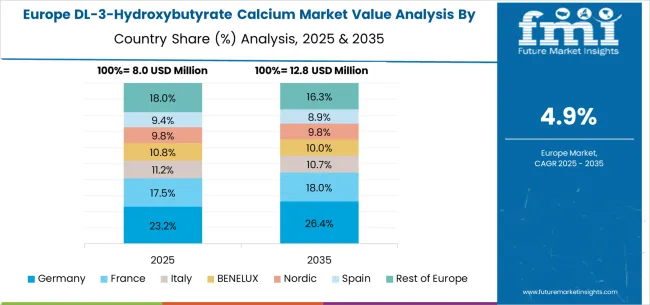
Demand for DL-3-Hydroxybutyrate Calcium in Germany is projected to grow at a CAGR of 6.2%, supported by the country's emphasis on premium health products, stringent quality standards, and advanced manufacturing technologies. German companies focus on pharmaceutical-grade production and specialized applications requiring highest purity specifications and comprehensive quality documentation. The market is characterized by premium positioning, technical excellence, and compliance with European Union regulatory frameworks governing food additives and dietary supplement ingredients.
Germany's chemical industry expertise enables advanced purification technologies and quality control systems that meet international pharmaceutical standards. Consumer preferences favor high-quality health products with proven efficacy and safety profiles, supporting premium pricing for certified ingredients. The regulatory environment provides clear guidelines for functional ingredient applications while maintaining consumer safety priorities through comprehensive approval processes.
Revenue from DL-3-Hydroxybutyrate Calcium in Brazil is growing at a CAGR of 5.7%, driven by expanding health and wellness market, increasing consumer awareness of functional ingredients, and growing dietary supplement industry development. The country's established food and pharmaceutical sectors provide foundation for specialty ingredient applications and commercial product development. Market growth reflects rising urbanization, increasing disposable incomes, and growing acceptance of preventive healthcare approaches among Brazilian consumers.
Brazil's regulatory environment continues developing frameworks for functional ingredients and dietary supplements, creating opportunities for broader commercial applications. The domestic market expansion benefits from increasing health consciousness and expanding retail distribution of wellness products across major metropolitan areas. Local manufacturing development and international partnership opportunities support market growth and product availability improvements.
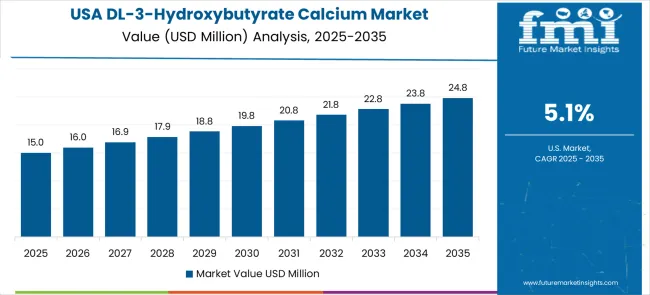
Demand for DL-3-Hydroxybutyrate Calcium in the United States is expanding at a CAGR of 5.1%, driven by established dietary supplement market, growing consumer interest in ketogenic dietary approaches, and expanding sports nutrition applications. The market benefits from advanced product development capabilities, comprehensive retail distribution networks, and consumer willingness to invest in premium health products with documented benefits. Regulatory frameworks support dietary supplement applications while maintaining product safety standards through established approval processes.
The United States market focuses on innovation, premium positioning, and brand differentiation through quality ingredients and comprehensive product formulations. Consumer preferences favor products with clinical research support, third-party quality certifications, and transparent labeling practices. Market maturation creates opportunities for specialized applications and targeted consumer segments including sports nutrition, clinical nutrition, and personalized wellness products.
The United Kingdom market for DL-3-Hydroxybutyrate Calcium is projected to grow at a CAGR of 4.6%, reflecting mature market conditions with established consumer awareness and well-developed distribution channels for health and wellness products. British consumers demonstrate strong preferences for quality-certified ingredients and products meeting European Union safety and efficacy standards. The market benefits from comprehensive regulatory frameworks and established supply chain relationships supporting consistent product availability and quality assurance.
Market development focuses on premium applications, specialized formulations, and targeted consumer segments including fitness enthusiasts, health-conscious consumers, and individuals following ketogenic dietary protocols. The regulatory environment provides clear guidelines for dietary supplement applications while maintaining rigorous safety standards through comprehensive approval and monitoring processes. Consumer education levels support informed purchasing decisions and brand loyalty development.
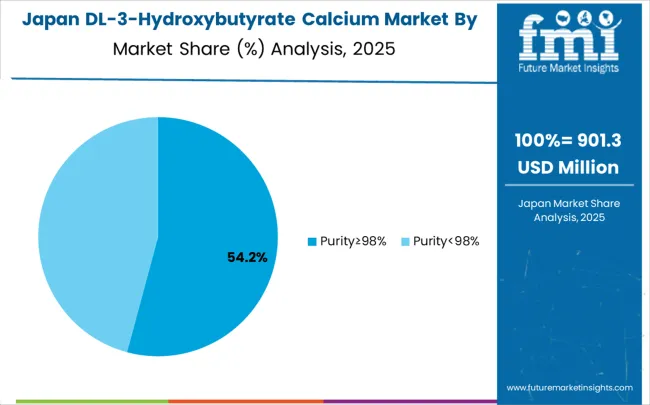
Revenue from DL-3-Hydroxybutyrate Calcium in Japan is expanding at a CAGR of 4.1%, characterized by stringent quality requirements, consumer preference for premium products, and comprehensive regulatory oversight ensuring product safety and efficacy. Japanese market dynamics emphasize quality differentiation, brand reputation, and long-term consumer relationships built through consistent product performance and transparent communication practices.
The market benefits from established health product distribution channels, consumer willingness to invest in proven wellness solutions, and regulatory frameworks supporting functional ingredient applications in dietary supplements and specialized food products. Manufacturing standards require comprehensive quality documentation and traceability systems supporting consumer confidence and regulatory compliance across all commercial applications and market segments.
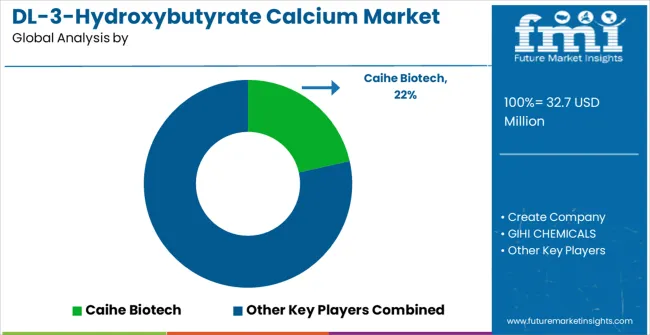
The DL-3-Hydroxybutyrate Calcium market operates through a concentrated competitive structure, with established chemical manufacturers, specialized ingredient suppliers, and emerging biotechnology companies competing across quality, cost, and technical capabilities. Market concentration is moderate, with top-tier suppliers focusing on pharmaceutical-grade production and premium applications, while second-tier players target cost-sensitive segments and regional markets.
Tier 1 competitors emphasize manufacturing excellence, global distribution, and quality certifications. These companies leverage advanced synthesis technologies, comprehensive quality control systems, and strong relationships with dietary supplement and pharmaceutical customers. Competitive strategies focus on capacity expansion, vertical integration, and premium positioning through quality differentiation.
Tier 2 suppliers compete on cost efficiency, regional knowledge, and specialized applications. They typically serve niche markets, regional customers, or specific quality grades, while building capabilities for broader market opportunities. Growth strategies include capacity expansion, quality improvements, and partnership development with downstream manufacturers.
Tier 3 players include emerging companies and specialized chemical producers entering via innovative production methods, niche applications, or regional expansion. They often focus on specific market segments or geographies while gradually enhancing capabilities and market presence.
Competitive dynamics involve technology transfer, supply chain competition, and customer acquisition. Market evolution trends suggest continued consolidation among smaller players, while established manufacturers expand capacity and geographic presence through strategic investments and partnerships.
DL-3-Hydroxybutyrate calcium represents a specialized biochemical compound positioned at the intersection of nutritional supplementation, functional foods, and metabolic health applications. With a market valued at USD 32.7 million growing to USD 55.3 million at 5.4% annually, this ketone body derivative benefits from increasing consumer interest in ketogenic nutrition, metabolic health optimization, and clean-label functional ingredients. The market's development requires coordinated efforts across regulatory agencies, biotechnology manufacturers, analytical testing providers, and specialized investment in fermentation and purification technologies.
How Governments Could Accelerate Market Development?
How Industry Bodies Could Support Market Standardization?
How Biotechnology and Processing Companies Could Strengthen the Ecosystem?
How Suppliers Could Navigate Market Requirements?
How Investors Could Unlock Market Potential?
| Item | Value |
|---|---|
| Quantitative Units (2025) | USD 32.7 million |
| Purity Grade | Purity≥98%, Purity<98%, Others |
| Application | Health Products, Food Additives, Pharmaceutical Intermediates |
| End-Use Industry | Dietary Supplement Manufacturers, Food Processing Companies, Pharmaceutical Producers |
| Distribution Channel | Direct Sales, Distributors, Online Platforms |
| Regions Covered | North America, Latin America, Europe, East Asia, South Asia & Pacific, Middle East & Africa |
| Countries Covered | United States, Germany, India, China, United Kingdom, Japan, Brazil |
| Key Companies Profiled | Caihe Biotech, Create Company, GIHI CHEMICALS, Shanghai KangXin Chemical, Anhui Integrity Biopharm, Qingdao Fengchen Technology Unilong Material Tangshan Moneide Trading Co., Ltd. Zouping Mingxing Chemical Co., Ltd. Chongqing Xingcan Pharmaceutical Co., Ltd. Accio |
| Additional Attributes | Dollar sales by purity grade, application, and end-use industry, regional consumption trends across North America, Europe, and Asia-Pacific, competitive landscape with established chemical manufacturers and emerging specialty suppliers, buyer preferences for pharmaceutical-grade versus industrial-grade materials, integration with ketogenic dietary trends and metabolic health research, innovations in synthesis technologies and purification processes, and development of specialized applications with enhanced bioavailability and stability characteristics for dietary supplement and functional food formulations. |
The global dl-3-hydroxybutyrate calcium market is estimated to be valued at USD 32.7 million in 2025.
The market size for the dl-3-hydroxybutyrate calcium market is projected to reach USD 55.3 million by 2035.
The dl-3-hydroxybutyrate calcium market is expected to grow at a 5.4% CAGR between 2025 and 2035.
The key product types in dl-3-hydroxybutyrate calcium market are purity≥98% and purity<98%.
In terms of application, health products segment to command 65.0% share in the dl-3-hydroxybutyrate calcium market in 2025.
Explore Similar Insights

Thank you!
You will receive an email from our Business Development Manager. Please be sure to check your SPAM/JUNK folder too.
Chat With
MaRIA